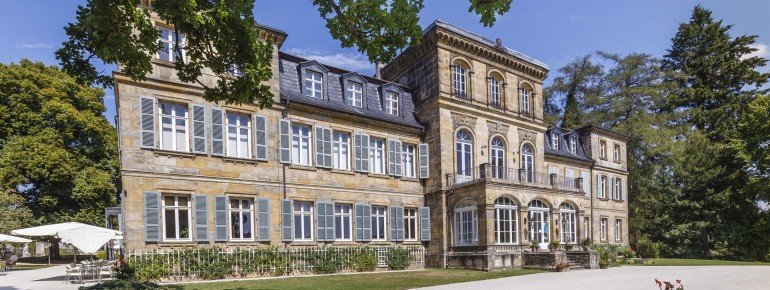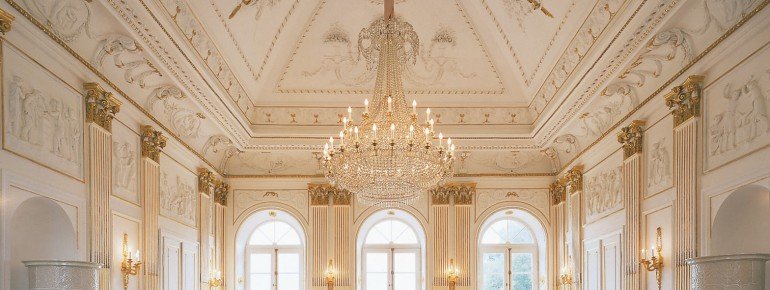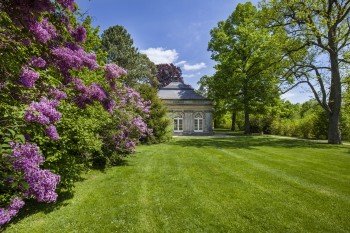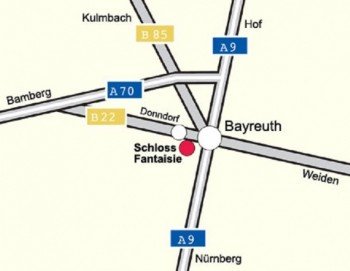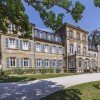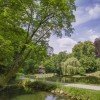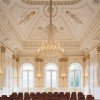Contents
Description
Fantaisie Castle west of Bayreuth was built between 1761 and 1763 and today houses, among other things, the first German garden art museum. Exhibits, productions and short films vividly depict the history of garden art. Particularly worth seeing in the little castle are the faithful replicas of the famous inlay cabinet of the Spindler brothers and the stucco decorated White Hall.
A stroll through the castle park, which combines elements from the Rococo, Sensitivity, Romanticism and Historicism periods, is also worthwhile.
Historical Information
Origins
Already in the Middle Ages there was a stately settlement in Donndorf, five kilometres west of Bayreuth. From the 16th century, the lords of Lüchau, who built a simple Renaissance castle in the middle of the beautiful landscape, had their seat here. After the death of the last lord of Lüchau in 1757, the property was returned to Market Count Friedrich von Brandenburg-Bayreuth.
New building
On a plateau above a steep rock face, the construction of a new palace was begun in 1761 on behalf of the market count. Here he wanted to put into practice the impressions he had gained during a trip to Italy. However, since Friedrich died in 1763, his daughter Friederike Sophie inherited Donndorf Castle, which she converted into her summer residence in the following years. Particularly noteworthy is the intarsia cabinet created by the Spindler brothers, which is considered one of the major works of the Bayreuth Rococo.
Rebuilding
In 1770 the castle received its present name: "Fantaisie". The niece of Frederick the Great and married Duchess of Baden-Württemberg had at that time detached herself from the Stuttgart court and spent the winter months in the Old Palace in Bayreuth, the summer months in Fantaisie. After her death in 1780, however, the castle was left to decay.
From 1793 Fantaisie was used by Duchess Friederike Dorothee Sophie von Württemberg, who had fled from the chaos of war in the Rhine area. During extensive renovations, she also had the White Hall, an elegant room decorated with stucco that has survived to this day, designed. In the course of time, however, the castle deteriorated noticeably.
First Duke Alexander II of Württemberg, a grandson of Duchess Dorothee Sophie, gives Fantaisie a new lease of life. From 1850 he had parts of the castle extended by one storey and the façade redesigned.
At the time of National Socialism the "Reichsschule Donndorf-Bayreuth" was accommodated in Fantaisie, later it served as a sanatorium for the Allies.
Interesting facts
- The day pass at Fantaisie palace and park Bayreuth is €4.50 making it one of the 10 cheapest tourist Attractions in Bavaria.
How to get there
Fantaisie Castle is about 9 km from Bayreuth. It can be reached by car in approx. 20 minutes, on foot in approx. 1.5 hours.
By car:
You can reach Fantaisie Castle from Bayreuth via the federal road B22 in the direction of Hollfeld to Donnersdorf/Eckersdorf. Car parking is available in front of the castle.
By public transport:
Buses 8231, 8433, 8446 and 8449 run from Bayreuth main station to Donndorf (stop "Fantaisie"). From ZOH you can get there by bus 325 "Hotel Fantaisie".

